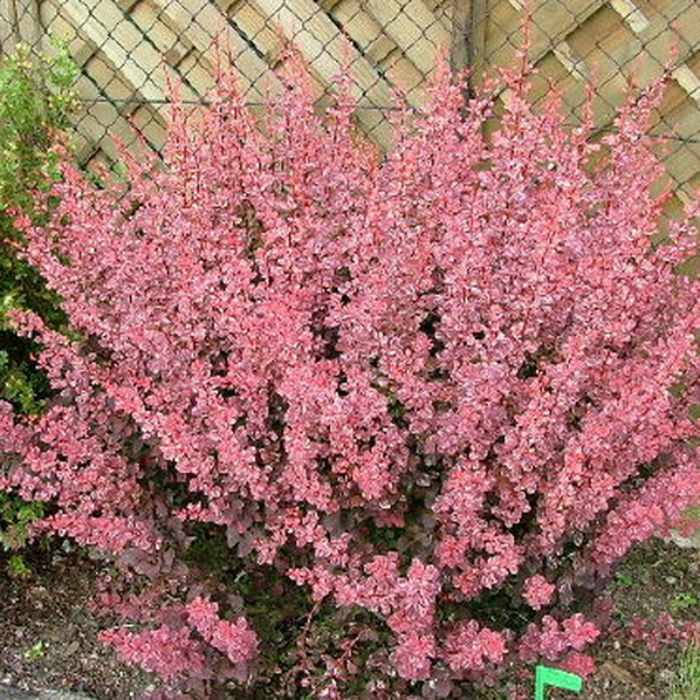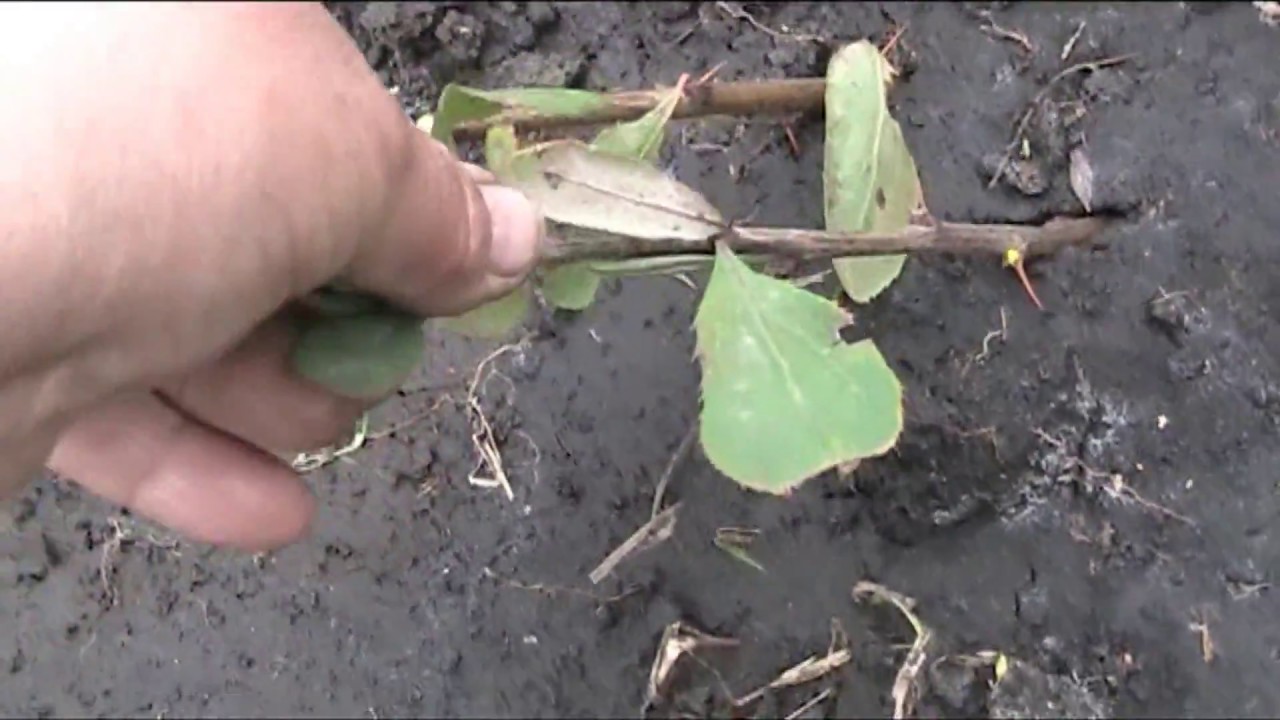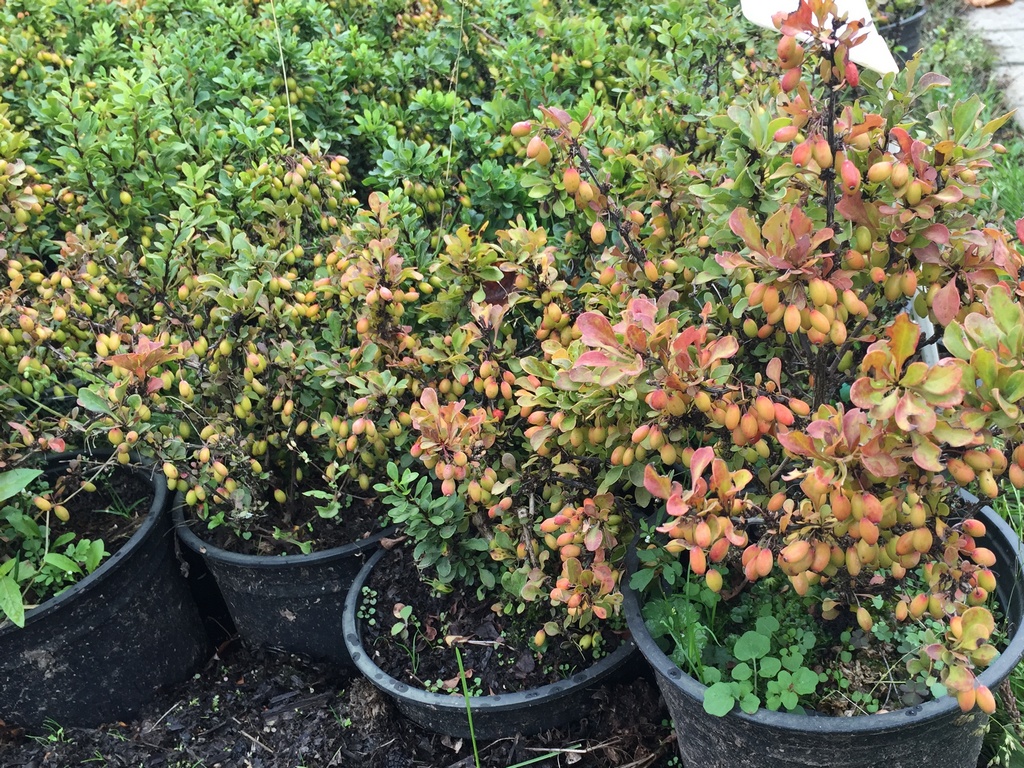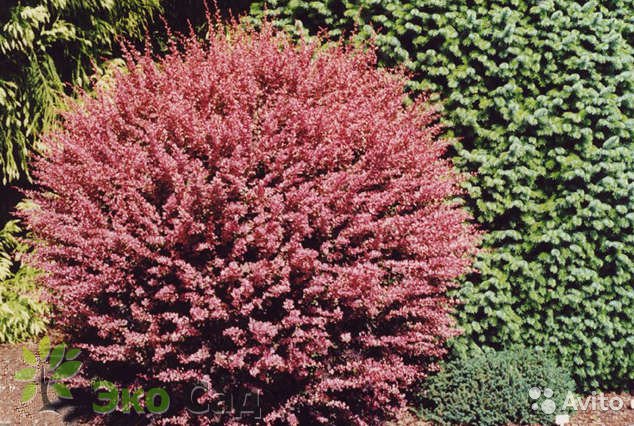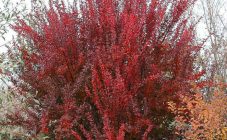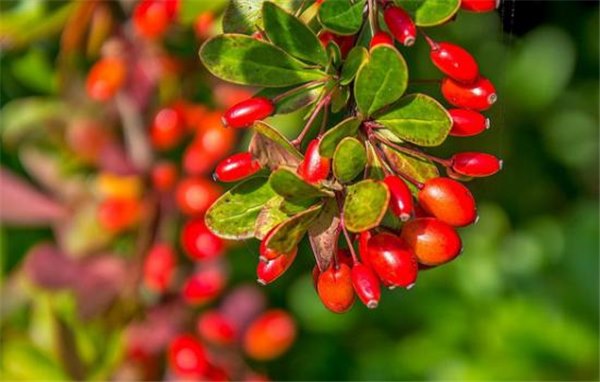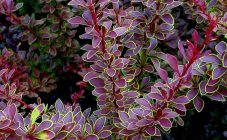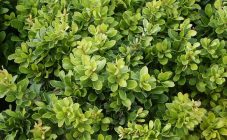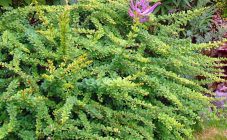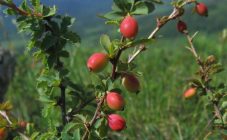There are currently more than 170 species of the barberry family. This family also includes the Thunberg barberry, with unique decorative properties. This deciduous shrub, which has a height of 0.6 to 2 meters, is used not only by designers in their projects, but also by those who like to plant beautiful ornamental shrubs in their garden.
In summer cottages barberry Thunberg planted as single plantings, and in the form of hedges and curbs. The bushes attract attention with their flowers in the spring, the multicolored leaves in the summer, the color scheme of which has options for yellow, green and red tones, and beautiful berries in the autumn-winter period.
Summer residents who grow tunberga barberry varieties on the plots are satisfied with its characteristics such as drought resistance, frost resistance, and not demanding soil. Shrubs are also attractive because, unlike other varieties of barberry, many varieties Berberis thunbergii are resistant to diseases such as powdery mildew and rust.
Agrotechnics
Planting bushes
Bushes are planted in early spring or late autumn. Breeders note that varieties of barberry varieties with red-burgundy leaves need bright sunlight, and those with different tones of green leaves feel great in partial shade. In this regard, one should choose where the bushes of this barberry should be placed on the personal plot or in the garden. The place for planting bushes should be protected from cold winds.
Gardeners engaged in the cultivation of this type of shrub note that they grow well on light, drained soils, do not like wetlands and the proximity of groundwater to the earth's surface. If the structure of the soil is heavy, it is necessary to plant the bushes in prepared pits, filling the roots with a mixture consisting of sand, humus and sod mud, maintaining a ratio of 1: 1: 2.
The planting process is normal, as for any tree or shrub:
- The hole should have a depth and diameter of about half a meter. If these are single plantings, the distance to a nearby plant is up to 2 meters. If you plan to make a hedge from the bushes of this variety, the bushes are planted half a meter apart. Some low-growing varieties of barberry, from which the hedge is formed, can be planted denser - after 30 cm.
- The bottom of the pit is covered with sand with a layer of 10-15 cm, for good drainage.
- The seedling is located in the center of the pit. The roots are straightened and sprinkled with the prepared mixture.
- Sprinkle the planted bush with water and tamp the soil.
- After the water is absorbed, mulch the soil under the bush with peat.
- Water once every ten days until the bush grows, but do not flood.
Thunberg barberry care
Since barberry is an unpretentious plant, caring for it is not difficult. Barberry is not picky about soils.However, feeding the plant with nitrogen fertilizer the following spring after planting will improve both root formation and spring branch growth. Further fertilization is often not worth it. It is enough to make fertilizing with urea once every three years, diluting 30 grams. on a bucket of water.
This is one such plant that has enough natural rainfall. It is necessary to water during periods of prolonged drought with warm water directly under the root and immediately mulch the space under the bushes. Frequent loosening of the soil is beneficial for barberries.
Pruning bushes is optional. Too long branches need to be shortened, in accordance with the conceived design of the bush, those in the hedge are cut in such a way that the hedge matches its original cut, removing excess growth. In addition to the usual decorative trimming of bushes, sanitary pruning is performed before the juice starts to move. Sick and dry branches are cut out.
Reproduction of bushes
Reproduction of bushes can be done in several ways: by seeds, cuttings, dividing a bush, layering, shoots. Seed propagation is the most laborious due to poor seed germination. Basically, breeders use this method. The best option is to propagate barberries by cuttings, for which a half-stiff shoot up to 20 cm long is taken. You can take cuttings from annual shoots with two internodes.
A good result is obtained when propagating by layering. It is necessary to dig in a low-growing branch from the mother bush, cover it with perforated film, which must be opened periodically during the summer season. Over the summer, the branch will take root, it can be separated from the mother plant. She is ready to be transplanted to the desired location. When dividing the bush, a ready-made seedling is immediately obtained. Usually the division of the bush is done in early spring before flowering, or in late autumn after ripening.
The best varieties
Barberry Atropurpurea
For hedges, there is no more beautiful shrub that has arched branches with red-orange shoots and purple-red leaves. We are talking about the Thunberg barberry Atropurpurea Nana, the most versatile plant for landscape planting. It looks great both in the arrangement of park areas and in landscape compositions of personal plots.
If we talk about atropurpurea nana, it has a dense crown with small leaves that retain a rich purple-red-brown color throughout the season, which is most intense when the leaf buds open. It blooms in early summer, oblong coral fruits ripen in September. Barbari atropurpureum is not picky about soils, especially since the mountain slopes of China and Japan are home to the sun.
Barberry Aurea
This ornamental shrub is perfect for urban environments. Designers from Aurea bushes create landscape compositions in park areas, squares, as well as in combined flower beds. The shoots of the bush are yellowish-green, the leaves are golden-yellow. It is this bright color of the foliage that gives the impression of being illuminated by the sun even in cloudy weather. There are thorns of the same color. The shrub blooms in May. The bright red fruits ripen by October and can hang on branches in winter.
Kobold
Kobold dwarf barberries are miniature shrubs with dark green shiny leaves, reaching 40 cm in height. By autumn, they "recolor", acquiring red and yellow leaf colors.The growth of branches over the year is small. The fruits of this shrub are bright red, edible, ripen in September.
It is used in landscape design as a border of low curbs, looks beautiful on alpine slides and near artificial ponds. The best breeding option for this variety is with seedlings purchased in containers. When planting a plant, the root system is not damaged, and the bush takes root well.
Barberry Golden Ring
One of the varieties of barberry that pleases the eye with its exquisite color. The shrub changes its color from purple to burgundy by the end of the autumn season. Incredibly beautiful burgundy leaves are edged with a bright yellow border. It is for this color that the shrub received the name Golden Ring, which translates as “golden ring”.
With this color of foliage, the shrub can be an accent color in a flower bed and look just as good in a hedge. Golden Ring grows fast enough, reaching two or more meters in height. Its scope is also rather big - up to 2.5 meters is the diameter of its spreading branches. Its maximum growth is completed by the age of 10. The bush is good because you can form the necessary parameters from its branches. Shrub trimming is well tolerated.
Barberry Bagatelle
This variety belongs to the slowly growing dwarf barberries, with a spherical bush shape. The leaves have an original purple-red color with a copper tint. Young shoots of the bush are yellow-green in color, have sparse thorns. It blooms with white flowers. The fruits are coral-red, ripen in mid-autumn and hang on the branches all winter.
The versatility of this variety allows you to plant bushes in landscape compositions, being their accent in hedges, complex color compositions, planting along the paths of the garden. It tolerates windy weather and urban conditions, temporary drought and pollution.
Barberry Thunberg Green Carpet
This shrub looks like a Persian rug. The plant is up to one meter high and up to one and a half meters in diameter. The crown is spreading. Like many varieties of barberry, it has the property of a chameleon, changing the color of the leaves from spring green, becoming orange-yellow in autumn. This shrub is light-loving, but slightly changing the color of the foliage, it tolerates partial shade.
It is used in landscape design, often being the center of the lawn, participates in group plantings, beautiful in tamping tall shrubs of hedges and borders.
Barberry Thunberg Pink Queen
The pink-spotted shrub is a variety of barberry Berberis Tunberga Pink Kvin (Atropurpurea Rosea). Its vertical shoots of branches are red, for which the shrub is called red-skinned. There are strong thorns on the branches. Adult leaves, like the branches on the outside of the bush, turn purple-red by autumn, inside it - greenish-red. The shrub blooms in late May, numerous fruits appear on the branches of Ping Queen by mid-autumn. Hang on the bushes all winter.
The bush is light-loving, but it also tolerates partial shade, reducing the intensity of the color of the leaves. Used in landscape projects to create framing curbs, recreation areas in parks. Possesses high winter hardiness. Freezing is sometimes possible.
Barberry Thunberg Red Pillar
The bush has a spiny columnar crown and purple-red leaves. Reaches a height of one and a half meters. Erect shoots. Blooms in June.The flowers are beautiful yellow with a reddish outside. In the middle of autumn, ellipsoidal red fruits ripen on the bushes. Loves light, the decorative effect of the bush reduces partial shade. Perfectly tolerates a haircut. In the case of cutting the branches at the root, it recovers well, quickly giving young shoots. Winter hardiness is high.
Barberry Thunberg Carmen
Landscape designers use it as a lawn specimen. This variety is versatile in design projects, like other Thunberg varieties.
Application in landscape design
Thunberg barberry hedges like Orange Rocket, Golden Dream, Coronita are real garden decorations. It takes about seven years to grow a hedge. But the finished hedge will delight the eye for a long time, not only for the owners of personal plots, but also for everyone who will see it when passing by. Any variety of barberry will decorate and diversify gardens and personal plots.
